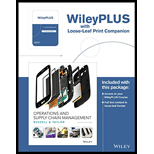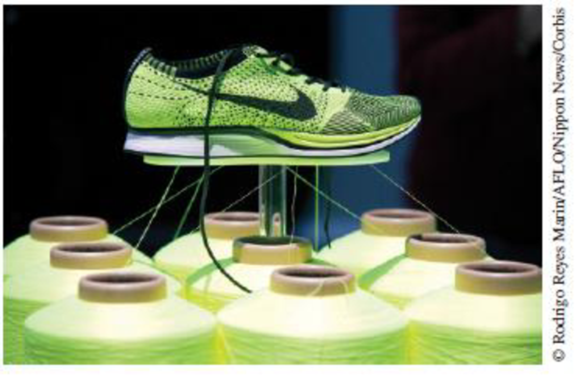
Consider Nike’s Flyknit Design
Nike has been aggressively pursuing sustainable design and production for more than a decade. Its Considered Design ethos asks designers to consider the environmental impact of a proposed product at the early stages of development; specifically, to use less toxins, less waste, more environmentally friendly materials, and more life cycle assessments (which promote recycling). To aid in that pursuit, Nike provides a list of environmentally preferred materials (EPM) and sustainable materials, as well as a restricted substances list (RSL) and restricted packaging list, to its suppliers and designers. A Considered Index is then calculated to evaluate the proposed design. Products or designs are scored on the use of solvents, waste, materials, treatments (such as fading or distressing), and innovation. Only those products that score significantly higher than the Nike average are designated as “Considered.”
The company has also developed a Sourcing & Manufacturing Sustainability Index (SMSI) that assesses contract factory performance on sustainability measures such as lean production, environmental performance (water, energy, carbon, waste), health and safety, and labor management factors. The company’s recycling program, called Reuse-A-Shoe, has recycled more than 21 million pairs of athletic shoes to create public basketball courts, athletic tracks, and playground surfaces around the world. Sustainability is now one of Nike’s core values, as noted in its recent annual report.
How appropriate, then, that one of Nike’s biggest commercial successes is also an environmental success—a 5.6 ounce running shoe called the Flyknit, which is shown in the photo. The Flyknit design changes the look, feel, performance, and manufacture of Nike’s biggest sales category, running shoes. The upper portion of these shoes are “knitted” on a custom-made 15-foot-long machine that weaves together colored polyester yarn and adds tiny synthetic cables into the weave around the midfoot for support. The cables loosen and contract with the runner’s foot, for form-fitting comfort and performance. For more stretch in the toe, Lycra-infused thread can be used; for added strength in the heel, multiple layers of yarn of varying thickness can be added. The warp and weft of the weaving process opens up interesting color combinations for the shoes as well. In the future, a shoe might be knitted to fit the particular needs of a customer’s feet (even if that means a different knit pattern for the left foot than the right).
The Flyknit has 35 fewer pieces to assemble than a traditional shoe and produces very little waste. Since there is no cutting, sewing, stitching, or gluing, the labor requirements and cost of manufacture are considerably less, too.

Nike has made great strides in apparel manufacturing, as well, with its ColorDry dyeing process. The new technology uses CO2 instead of water to dye material, eliminating wastewater pollution and avoiding depletion of a resource that is becoming increasingly scarce. Since it takes 30 liters of water to dye just one T-shirt and 5.8 trillion liters of water to dye apparel each year across the industry, using zero water makes a huge difference. The new process is 40% faster, too; it uses a quarter of the space and reduces energy consumption by 63%. Further, the color is more saturated, intense, and consistent.
Nike’s environmental actions promise to be a game-changer both for the company and the industry, and the resulting increase in profit is not bad either.
Why do you think Nike is so concerned about sustainability and the environment?
Want to see the full answer?
Check out a sample textbook solution
Chapter 4 Solutions
Operations and Supply Chain Management, 9th Edition WileyPLUS Registration Card + Loose-leaf Print Companion
Additional Business Textbook Solutions
Operations Management: Sustainability and Supply Chain Management (12th Edition)
Business in Action (8th Edition)
Business in Action
Operations Management, Binder Ready Version: An Integrated Approach
Operations Management: Processes and Supply Chains (12th Edition) (What's New in Operations Management)
Operations Management: Processes and Supply Chains (11th Edition)
- Analyze a specific product or service that utilizes persuasive technology. How does it leverage persuasive design principles to achieve its goals?arrow_forwardDescribe Standardize and Simplify Product Design?arrow_forwardWhat is durable design, and how does it influence product growth and production?arrow_forward
- Discuss any 4 principles of good product design. Quality, Utility/functionality, Asthically pleasing and profitability.arrow_forwardExplain products or service design activities and what is the objectives of design?arrow_forwardCan you use typing to explain the things above. Please avoid plagiarism and use your own wordsarrow_forward
- How can design be used in relation to the creation and marketing of a product in each of the four phases of the Product Life Cycle?arrow_forwardWhat methods can be used to convey information and identify sustainability improvements?arrow_forwardJohnson & Johnson Acuvue contact lenses product Action Plan and Implementation Research the impacts assessment, it should reveal opportunities for improvements. Outline specific goals and targets based on your review of Acuvue contact lenses. Once you have prioritized your action ideas, flesh out your intents for each action item.arrow_forward
- Company: Johnson & Johnson Product: ETHICON™ 3D Pre-operative Planning Describe the product you will be representing to your fictional buyerarrow_forwardDescribe the concept of software product analytics and how it can be used to gather insights into user behavior, product performance, and feature usage. How do these insights inform product improvement decisions?arrow_forwardThink of three products or services that employ:a) Interchangeabilityb) Standardisationc) Modular designarrow_forward
 Practical Management ScienceOperations ManagementISBN:9781337406659Author:WINSTON, Wayne L.Publisher:Cengage,
Practical Management ScienceOperations ManagementISBN:9781337406659Author:WINSTON, Wayne L.Publisher:Cengage, Operations ManagementOperations ManagementISBN:9781259667473Author:William J StevensonPublisher:McGraw-Hill Education
Operations ManagementOperations ManagementISBN:9781259667473Author:William J StevensonPublisher:McGraw-Hill Education Operations and Supply Chain Management (Mcgraw-hi...Operations ManagementISBN:9781259666100Author:F. Robert Jacobs, Richard B ChasePublisher:McGraw-Hill Education
Operations and Supply Chain Management (Mcgraw-hi...Operations ManagementISBN:9781259666100Author:F. Robert Jacobs, Richard B ChasePublisher:McGraw-Hill Education
 Purchasing and Supply Chain ManagementOperations ManagementISBN:9781285869681Author:Robert M. Monczka, Robert B. Handfield, Larry C. Giunipero, James L. PattersonPublisher:Cengage Learning
Purchasing and Supply Chain ManagementOperations ManagementISBN:9781285869681Author:Robert M. Monczka, Robert B. Handfield, Larry C. Giunipero, James L. PattersonPublisher:Cengage Learning Production and Operations Analysis, Seventh Editi...Operations ManagementISBN:9781478623069Author:Steven Nahmias, Tava Lennon OlsenPublisher:Waveland Press, Inc.
Production and Operations Analysis, Seventh Editi...Operations ManagementISBN:9781478623069Author:Steven Nahmias, Tava Lennon OlsenPublisher:Waveland Press, Inc.





